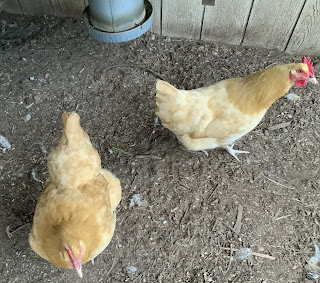 |
| Last two hens |
For the first five days after the attack, they wouldn’t leave the coop--not for food, not for water. It appeared that they were spending the days just milling around the coop floor or hanging out on the platform under their roost.
I would open the man door and try to reassure them they would be safe, coax them out with feed or scratch, but they wouldn’t budge. All I could do was sprinkle some feed on the wood chips on the floor, which they would peck at halfheartedly. I put a bucket of water in the coop too, since they wouldn’t come out to drink out of their regular waterer.
Their eating pattern had changed too: usually, fresh feed in the feeder
would have them eating with gusto. Now they’d only peck at the bits, once,
twice, then stop eating, lift their heads and look around.
Finally, the day came when they came out of the coop of their own
accord. Since then, they are emerging once or twice a day to eat--once again, do their "peck-peck-look around" for only a few
minutes. Then they'll disappear back
into the coop.
Yesterday, I did see an encouraging sign they might return to their normal, energetic girls: there were little round depressions in the loose dirt in one corner of their caged pen—they’d been dust-bathing!
Dust-bathing is an instinctive
behavior of laying hens: they will scratch out a shallow hole, and sink right
into it, fluffing the soil around them with their wings. The goal is to get
dirt in and among their feathers, which apparently discourages parasites.
Despite that positive sign, there’s another distressful indication that things aren’t right:
they’d been excellent layers before the hen was killed, but the two girls left
haven’t laid since the attack.
After a hawk killed one of our hens years ago (our first flock), the five girls remaining had also hunkered down in the coop--but only for three or four days afterward.
These two hens are clearly less resilient.
I wonder if it’s the breed: the girls are Buff Orpingtons, more of a
gentle type of laying hen. And since this flock (before losing the three to predators) has been so
prone to broodiness, it could be they’re very comfortable spending days on end
inside their coop.
But it’s sad to see them decline. Without light, their combs are
turning paler. And they seem to have lost their zest. What wouldn’t I give for
one of them to peck at my legs again, telling me, “C’mon, I want some special
treats!”
With the constant pressure from predators around here, sometimes I feel
we’re in a losing battle. Our neighbors lost a 3rd hen the week
before the attack at our place—and now they’re down to only three chickens. They,
and John and I, have come to the same conclusion: our only solution to get our
hens back into light and free-ranging opportunities is to cover their yard with
netting or steer wire.
For us, it’ll be a big job: our yard is at least 15’x15’. We’ll need
some new supports going down the middle, and the way hens scratch, making huge
divots in the ground, it’ll take a lot of muscle to bury the supports deep
enough.
For now—at least until our two girls are interested in venturing back
into the sunshine—their caged pen will have to do.
We have already changed our egg consumption. Gone are the days of being lavish with our supply, having eggs whenever we wanted: 3-egg omelet, anyone?
Not any more. We currently have a bunch stored in the shop fridge, but
without any expectation of more eggs, we will be parsing out our intake. The next step is buying store eggs for baking, to help stretch our own supply.
No comments:
Post a Comment